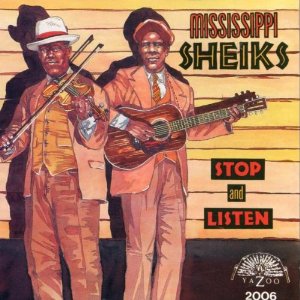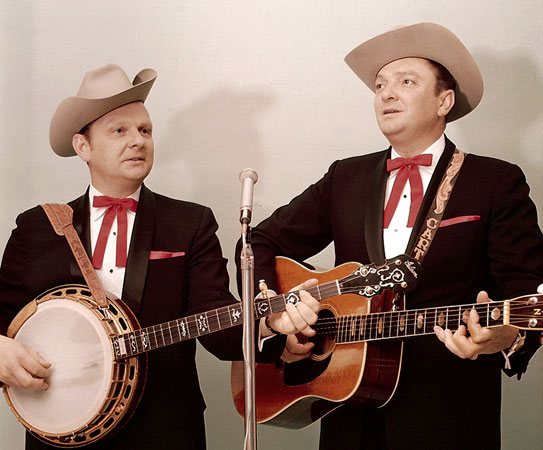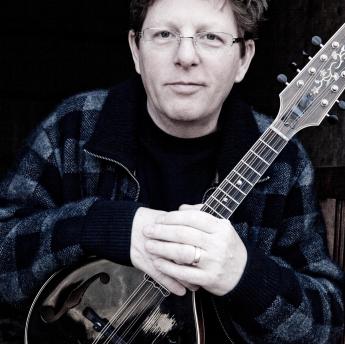This is just a cheap excuse to share some of my favorite bluegrass tunes, most of which have a strong blues influence.
I’m sure you can find several qualified musicologists who can speak at length about how the blues – as well as the obvious Scottish, Irish and English influences – helped shape bluegrass in the ‘30s and ‘40s and continues to serve as one of its primary roots. I’ll simply defer to my brother James, who has played many of these songs hundreds of times throughout several decades as a working bluegrass musician:
“Nobody put more blues in bluegrass than Bill Monroe, and since he pretty much invented the form, you have to say that blues is just part of it. Some bluegrass players emphasize it more than others, but none more than Bill. I don’t think he did it consciously, it’s just the music that was around him when he was learning how to play. In fact, it was right in front of him, because he learned partly from a black fiddler and guitarist, Arnold Shultz.”
Monroe described Shultz’s significance in an interview with Doug Benson, a Canadian bluegrass enthusiast (from The Bill Monroe Reader, by Tom Ewing): “…he could play some of the prettiest blues that you ever listened to… and me and him has played for some dances, you know, just the fiddle and guitar. But that’s where the blues come into my life, hearing old Arnold Shultz play ‘em.”
 A prime example of the blues influence on bluegrass is the tune Sitting on Top of the World, which has been covered by both Monroe and Howlin’ Wolf as well as many other artists in a wide range of genres (I also have a swingin’ version by Bob Wills). The song was written by Walter Vinson and Lonnie Chatmon of the country blues band the Mississippi Sheiks, which originally recorded the tune in 1930 for the Okeh label. That was roughly the same time Monroe was putting his first band together with his brothers Birch and Charlie, so I’m sure the tune didn’t miss their attention. But it took Monroe 27 years to record his own version of Sitting with his Bluegrass Boys. This next sample combines the Sheiks’ original with Monroe’s cover… interesting to hear the string band influence on the Sheiks, and Monroe’s obvious weakness for blues riffs and phrasings. Sitting on Top of the World (Sheiks/Monroe)
A prime example of the blues influence on bluegrass is the tune Sitting on Top of the World, which has been covered by both Monroe and Howlin’ Wolf as well as many other artists in a wide range of genres (I also have a swingin’ version by Bob Wills). The song was written by Walter Vinson and Lonnie Chatmon of the country blues band the Mississippi Sheiks, which originally recorded the tune in 1930 for the Okeh label. That was roughly the same time Monroe was putting his first band together with his brothers Birch and Charlie, so I’m sure the tune didn’t miss their attention. But it took Monroe 27 years to record his own version of Sitting with his Bluegrass Boys. This next sample combines the Sheiks’ original with Monroe’s cover… interesting to hear the string band influence on the Sheiks, and Monroe’s obvious weakness for blues riffs and phrasings. Sitting on Top of the World (Sheiks/Monroe)
Those influences get even more tangled up in Monroe’s classic train song, I’m Blue, I’m Lonesome. “That tune is very similar to Monroe’s version of In The Pines – a song that was recorded in 1929 by both Dick Justice, who was white, and Peg Leg Howell, who was black,” says James. “The origins of In The Pines go back even further, but the point is, Monroe couldn’t avoid writing songs that drew from the blues tradition.” As Monroe himself pointed out about the form he helped create, “It’s blues and jazz, and it has a high lonesome sound.” I’m Blue, I’m Lonesome
He also couldn’t avoid the influence of Appalachian string bands that were popular following World War I – especially Charlie Poole and the North Carolina Ramblers. Since we’ve already determined that bluegrass music started with Monroe, this next tune falls a little bit out of our formula. But it shows that a few Appalachian string bands were playing blues-based music long before Bill Monroe and his Bluegrass Boys hit the scene. Recorded in 1926, the song chronicles the assassination of President William McKinley – a tragic event that somehow worked to the advantage of at least one person: “Roosevelt in the White House drinking out of a silver cup; McKinley in the graveyard, he’ll never wake up… He’s gone a long, long time.” Looks like Teddy didn’t waste any time charging up that hill: White House Blues
As nephew Dan likes to point out, bluegrass is really white soul music. And it doesn’t get much more soulful than the Stanley Brothers. Ralph and Carter recorded a number of classics during their 20 years together with the Clinch Mountain Boys, and you can’t miss the blues in the best of them. Here’s a traditional song from the 18th Century that was revived by the Carter Family in 1930 and recast as a folkie singalong by the Weavers in 1950. But the Stanley Brothers gave it the gravitas it deserved in their final live performance on October 16, 1966, at the Brown County Jamboree in Bean Blossom, Indiana (the hard-living Carter died several weeks later from liver failure at the age of 41): Worried Man Blues
Jimmy Martin was another bluegrass innovator who played with a strong blues feel. Probably had a lot to do with his stint as lead vocalist for Bill Monroe and his Bluegrass Boys, from 1949 to 1953. In fact, Martin played a key role in the evolution of Monroe’s “high lonesome” sound (that’s Martin’s high harmony on I’m Blue, I’m Lonesome). He also played a pretty mean, hard-driving guitar, which served as the prototype for many bluegrass pickers who followed. Here’s a tune Martin recorded with his Sunny Mountain Boys in ’68 – probably inspired The Allman Brothers’ Dickey Betts five years later when he wrote Ramblin’ Man: Free Born Man
You don’t have to dig very deep to find the blues in contemporary bluegrass and Americana artists like the SteelDrivers, Rhonda Vincent, Tim O’Brien, Darrell Scott, Del McCoury, Gillian Welch, The Wood Brothers, Cahalen Morrison & Eli West… O’Brien and Scott collaborated on an especially strong release from 2000 (“Real Time”) that included an inspired cover of a blues tune by Blind Willie Johnson, Keep Your Lamp Trimmed and Burnin’. You might be more familiar with another version by Fred McDowell, or an eight-minute live workout by Hot Tuna featuring the late, great Papa John Creach on fiddle. I may be a blues snob, but I can’t get enough of this one – with O’Brien tearing it up on mandolin and Scott showing us what harmony singing is all about. Keep Your Lamp Trimmed and Burnin’
We featured this band in a previous post about their former mandolinist, Mike Henderson, who also played some fearsome blues guitar in Nashville with his band the Bluebloods. The original lineup of Henderson’s bluegrass band, the SteelDrivers, also included a country boy who could flat-out sing the blues, Chris Stapleton. Chris moved on to a more rockin’ band, the Jompson Brothers, and continues to write songs for country royalty such as George Strait and Kenny Chesney. But I sure miss his gritty vocals on bluegrass tunes like this one, which offers another clinic in harmony singing – here courtesy of the red-hot fiddler Tammy Rogers: Blue Side of the Mountain
 Steve Earle’s storied collaboration with the Del McCoury Band didn’t last very long… Apparently McCoury wasn’t very fond of Earle’s outspoken political views and foul language (here’s a signature sign-off from his 2000 release “Transcendental Blues”: Let’s magnetize…). But he loved Earle’s songs, which sounded like they were written by Monroe back in the Forties. This next tune already has been adopted as a standard by a number of contemporary bluegrass and folk musicians, which is exactly what Earle intended when he wrote it. The Mountain
Steve Earle’s storied collaboration with the Del McCoury Band didn’t last very long… Apparently McCoury wasn’t very fond of Earle’s outspoken political views and foul language (here’s a signature sign-off from his 2000 release “Transcendental Blues”: Let’s magnetize…). But he loved Earle’s songs, which sounded like they were written by Monroe back in the Forties. This next tune already has been adopted as a standard by a number of contemporary bluegrass and folk musicians, which is exactly what Earle intended when he wrote it. The Mountain
Here’s another fine example of contemporary bluegrass with a healthy dose of blues – Cahalen Morrison & Eli West, live at KEXP studios in Seattle…
And here’s the guy who started it all – Bill Monroe, live at the Grand Ole Opry, 1956:






